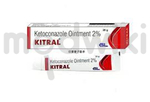ketonid
Introduction to ketonid
Ketonid is a powerful medication used to treat serious fungal infections that occur deep within the body. It is typically prescribed when other treatments have failed or are not suitable for the patient. However, it is not effective for treating fungal infections of the skin, nails, or the membranes surrounding the brain and spinal cord.
Composition of ketonid
The active ingredient in ketonid is Ketoconazole, which works by inhibiting a specific fungal enzyme. This action disrupts the synthesis of ergosterol, an essential component of the fungal cell membrane, ultimately leading to the death of the fungal cells.
Uses of ketonid
- Treatment of serious internal fungal infections
- Used when other antifungal treatments are ineffective or not tolerated
Side effects of ketonid
Common side effects:
- Upset stomach
- Headache
- Diarrhea
- Abnormal liver test results
Serious side effects:
- Liver damage
- Severe allergic reactions
- Low adrenal gland function at high doses
- Muscle issues when taken with certain other medicines
- Dangerous heart rhythm problems
Precautions of ketonid
Ketonid can cause serious liver damage, so it is important to avoid alcohol and other liver-harming medications while taking it. It should not be taken with certain other medications, such as dofetilide, quinidine, pimozide, lurasidone, cisapride, methadone, disopyramide, dronedarone, or ranolazine, as these can cause heart problems. If you experience symptoms like rash, itching, swelling, fever, chest pain, or trouble breathing, seek medical attention immediately.
How to Take ketonid
- For adults, the typical starting dose is 200 milligrams per day, which can be increased to 400 milligrams if necessary.
- For children over two years old, the dose is based on weight, usually between 3.3 and 6.6 milligrams per kilogram of body weight.
- This medication is not recommended for children under two years old.
Conclusion of ketonid
Ketonid is a potent antifungal medication used to treat serious internal fungal infections when other treatments are not effective. While it can be highly effective, it is important to be aware of its potential side effects and interactions with other medications. Always follow your healthcare provider's instructions and report any unusual symptoms immediately.
Similar Medicines
Available in 2 variations

Ketonid 2% Cream 50gm
Ketonid 2% Cream 50gm
tube of 50 gm Cream

Ketonid Shampoo
Ketonid Shampoo
bottle of 100 ml Shampoo
Related Faqs

Is Ketonid an antibacterial agent?
Ketonid does not possess antibacterial properties instead it serves as an antifungal medication specifically designed to combat dandruff The primary culprit behind dandruff formation is a fungus called Pityrosporum orbiculare also known as Malassezia furfur This particular fungus plays a pivotal role in the development of dandruff By virtue of its antifungal nature Ketonid proves highly effective in targeting and eliminating the fungal infection responsible for dandruff occurrence

What if someone accidentally swallows Ketonid?
Ketonid is an externaluse medication designed to be used with caution to prevent its ingestion While accidental swallowing is generally considered harmless it is important to take necessary precautions to avoid any potential risks If you become concerned about accidentally ingesting Ketonid it is advisable to promptly seek medical guidance from your healthcare provider The primary purpose of Ketonid is to treat specific skin conditions externally Therefore it is crucial to apply the medication only on the affected areas and ensure it does not come into contact with the mouth or mucous membranes This preventive measure helps minimize the chances of accidental ingestion In case you accidentally swallow Ketonid or suspect that you may have done so it is essential to address any apprehensions without delay Contacting your doctor or seeking medical attention promptly can provide reassurance and guidance in such situations While accidental ingestion is generally considered safe it is always advisable to consult a healthcare professional for personalized advice and any necessary followup steps Remember when using Ketonid or any other medication careful application and adherence to the recommended usage guidelines are essential for both effectiveness and safety

How often should I use Ketonid?
If you are utilizing Ketonid to address dandruff concerns it is recommended to limit its usage to twice a week However if your intention is to prevent dandruff you should use it just once a week It is crucial to adhere to the recommended frequency and avoid exceeding the usage instructions for Ketonid Overusing this product may lead to undesired effects and could potentially undermine its effectiveness in combating dandruff Therefore it is imperative to exercise caution and strictly follow the prescribed guidelines when incorporating Ketonid into your hair care routine Remember consistency and moderation are key in achieving the desired results while maintaining healthy hair and scalp By incorporating Ketonid into your routine as advised you can effectively manage dandruff without unnecessarily exposing your hair and scalp to excessive product application

What if someone accidentally swallows Ketonex?
When using Ketonex it is important to only apply it externally and be careful to prevent any accidental ingestion While unintentionally swallowing Ketonex usually does not cause any significant harm it is still advised to seek medical advice from your healthcare provider if concerns arise To avoid any oral exposure to the product it is essential to exercise extreme caution In the event that Ketonex enters your mouth it is recommended to take immediate precautions by contacting your doctor without any delay
Related Posts

1:15
Are Your Hormones Out Of Balance? Signs & Symptoms!

1:15
How Do You Know If You Have a Vaginal Infection? Warning Signs!

1:15
Top Health Benefits of Cinnamon | How to Use It for Better Health!

1:15
Is Your Blood Pressure Too Low? What Are the Best Remedies to Fix Low Blood Pressure Instantly?

1:15
Mala D: How it works, When and How to take Mala D and Side Effects of Mala D!





















.svg)
